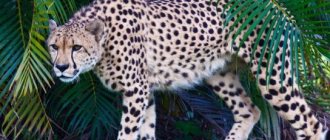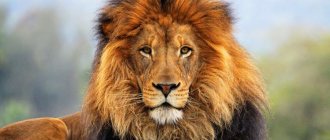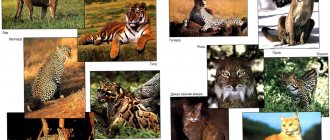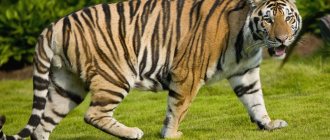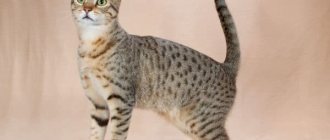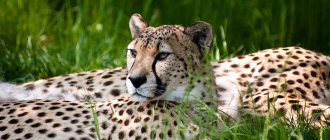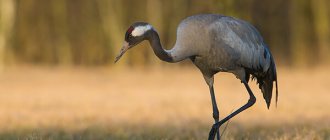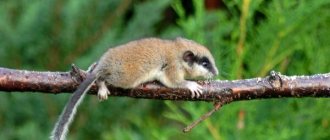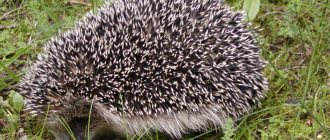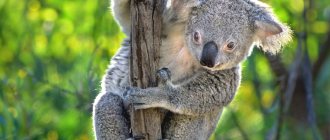The cheetah is one of the most predatory and fastest animals on the planet, which are part of the cat family. It should be noted that the speed of the cheetah is second only to the jaguar, however, the maximum speed that a cheetah can reach will be approximately 110 to 115 km/h.
The population of this mammal species is not high.
Origin of the species
Cheetahs appeared on Earth long before humans. Their ancestors almost disappeared during the last ice age, but managed to adapt to changing weather conditions.
Appearance of a cheetah
Appearance of a cheetah
Appearance of a cheetah
Appearance of a cheetah
Appearance of a jaguar
For a long time, these animals were mistakenly classified as a separate cheetah family, only indirectly classifying them as dogs and cats. But later, scientists established a direct relationship with pumas, which is why it was decided to classify cheetahs together with them in the subfamily of small cats.
Now there are several subspecies living on the planet, differing in habitat and color. Previously, zoologists had identified many varieties of predators, but upon detailed study at the molecular level, it was proven that they all belong to other species of cheetahs, and their DNA was slightly changed due to minor mutations.
Interesting fact : Some believe that in the distant past, cheetahs had long fangs on the upper jaw, like saber-toothed tigers, but this has not been proven.
Cheetah, leopard and jaguar - how are they different?
In appearance, the cheetah resembles a leopard, but the cheetah is slightly taller than the leopard, and has a more slender, lean body, long limbs and a relatively small head. The leopard has dark ring-shaped spots on its skin, and does not have black tear stripes on its face like the cheetah. The jaguar is much larger and more massive than the leopard, it has a strong body, short, powerful legs and a large head. The spots on a jaguar's skin are large, rosette-shaped, with small dark dots inside.
Evolution
Cheetahs boast some pretty interesting evolution and development. When their population declined sharply during the Ice Age, and the surviving individuals managed to adapt to the surrounding conditions, they needed to restore their numbers. Because of this, inbreeding of related animals began, which gave rise to the effect of homogamy.
Two cheetahs from the same population
Yes, this made it possible to quickly reproduce and populate the planet, but due to the appearance of cubs from close relatives, their gene pool was disrupted. Because of this, the animals are still paying the price. Now almost all cheetahs are so similar in DNA that individuals from neighboring populations may well be considered close blood relatives.
Given this characteristic, it is not surprising that newborn cheetah cubs can have health problems and often do not live beyond the age of one year, facing severe health problems. This is a clear example of how evolution can have a negative effect.
Scientists around the world are trying to find a way to help animals, but so far they have not been able to stop genetic degeneration.
Keeping animals at the Moscow Zoo
Cheetahs have been kept in the Moscow Zoo for a long time, and our zoo is one of the very few in which cheetahs have repeatedly given birth.
The cubs were first born in 1980 from parents who came from Africa. The female and male lived in the same enclosure, and the staff did not place the male in advance; the cubs were born in his presence. Dad was surprised, however, fortunately, he did not show any aggression towards the children, although in nature a male cheetah, especially a hungry one, can be dangerous for children. This pair of cheetahs lived in the zoo for a long time, repeatedly bringing and raising offspring. They also had grandchildren. The female cheetahs of our zoo were good mothers, but some, due to anxiety from people, did not provide their cubs with proper attention, and the staff had to take on parental care. Some of the young cheetahs went to other zoos, while others lived their lives here. Zoos around the world actively exchange animals to avoid inbreeding, which is especially important for cheetahs - these animals have an extremely uniform genotype.
Currently, cheetahs live in the Moscow Zoo on the Old Territory next to the Giraffe House. An enclosure complex has been created here for them; there are animals of both sexes, but they live nearby, so, unfortunately, the relationship between the male and females is purely friendly, and no cubs are born. This phenomenon has long been known; in specialized breeding nurseries for cheetahs, males are kept away from females, and pairs are united only for a while. Cheetahs successfully breed in the zoo's nursery, where these characteristics of the animals are taken into account.
Cheetahs are quite difficult animals to keep - they are tough and vulnerable at the same time. They are not afraid of mild frosts, but they cannot tolerate drafts and sudden temperature changes. Cheetahs can walk in the rain, but the interior must be dry (no more than 45% humidity). In autumn and spring, cheetahs often suffer from respiratory diseases. Panleukopenia, which can be carried by domestic cats, is very dangerous for these animals, especially at a young age, so all cheetahs must be vaccinated. Cheetahs are friendly towards people, however, they are very worried if a stranger enters the office premises.
Cheetahs are fed the meat of various animals, they especially love rabbits. One day a week for them, like all predators, is a fasting day.
Description
From the appearance of the cheetah, it is not difficult to guess that it belongs to the cat family. The head and structural features of the body immediately reveal this affiliation. However, predators have individual characteristics that not only set them apart from related animals, but also make them quite beautiful.
Color
The cheetah's body is covered with black spots.
Cheetahs have yellow-white fur with black spots randomly scattered throughout the body. On the tail, the spots gradually turn into rings. This color helps in hunting, since the animal blends into dry grass and becomes invisible to prey. This also helps when hiding from large predators.
Interesting fact : on the head of a cheetah, black stripes of fur run from the eyes to the mouth. They function as sunglasses and help you concentrate on your goal.
In the first months, newborn cubs have a different color: a dark belly and a light back. This protects them from enemies who might mistake them for honey badgers. Lions, hyenas and birds do not favor the latter as food.
Royal cheetah
Comparison of the color of an ordinary cheetah and a royal cheetah.
The peculiarity of these predators lies in their color. The king cheetah has thick black stripes on its back, and the spots on its body are much larger and can be connected to each other.
For a long time, royals were considered a separate species, but in the 1980s it was proven that they are born from ordinary cheetahs. For an animal to appear with this color, a recessive gene must be passed on from both parents.
Paws
Close-up of a cheetah's paw.
The paws are similar to those of other felines, but have semi-extended claws and harder pads. This increases traction while running, allowing you to push off harder and maneuver corners. The paws are also equipped with powerful muscles.
Teeth
Close-up of a cheetah's mouth
Since a cheetah develops great speed when running, it requires a lot of oxygen. To ensure that enough air enters the lungs, nature awarded the predator with large nostrils. This leaves little room in the upper jaw for tooth roots, making them physically unable to support larger teeth.
Interesting: Giraffe
